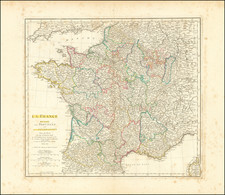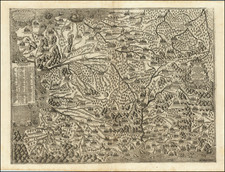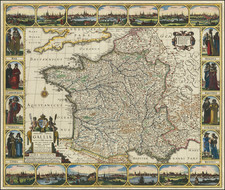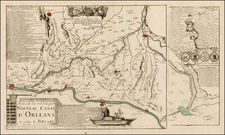Broadside Battle Map of the Battle of Malplaquet
Highly detailed broadside map showing the Battle of Maplaquet in Northern France, fought on September 11, 1709, one of the major battles of the War of Spanish Succession.
The plan title appears in both French and German and is accompanied by 4 columns of text in French at the bottom, entitled "Relation de la Victoirieuse Bataille Donnee pres Malplaquet & Longueville . . . ", giving a detailed account of the battle.
Battle of Malplaquet
The War of Spanish Succession pitted the Grand Alliance (consisting of Austria, Bavaria, Brandenburg, the Dutch Republic, England, Ireland, the Palatinate of the Rhine, Portugal, Savoy, Saxony, Scotland, Spain and Sweden) against the French Armey. The Grand Alliance campaign of 1709 began in mid June. Unable to bring the French army under Marshal Villars to battle owing to strong French defensive lines and the Marshal's orders from Versailles not to risk battle, the Duke of Marlborough concentrated instead on taking the fortresses of Tournai and Ypres. Tournai fell after an unusually long siege of almost 70 days, by which time it was early September, and rather than run the risk of disease spreading in his army in the poorly draining land around Ypres, Marlborough instead moved eastwards towards the lesser fortress of Mons, hoping by taking it to outflank the French defensive lines in the west. Villars moved after him, under new orders from Louis XIV to prevent the fall of Mons at all costs - effectively an order for the aggressive Marshal to give battle. The two armies faced each other across the gap of Malplaquet, south-west of Mons.
The Allied army, mainly consisting of Dutch and Austrian troops, but also with considerable British and Prussian contingents, was led by the Duke of Marlborough and Prince Eugene of Savoy, while the French were commanded by Villars and Marshal Boufflers. The allies had about 86,000 troops and 100 guns and the French had about 75,000 and 80 guns, with the two sides encamped within cannon range of each other near what is now the France/Belgium border.
At 9.00am on September, 11 the Austrians attacked with the support of Prussian and Danish troops under the command of Count Albrecht Konrad Finck von Finckenstein, pushing the French left wing back into the forest behind them. Prince Eugene was wounded twice in the fighting. The Dutch under command of John William Friso, Prince of Orange, on the Allied left wing, attacked the French right flank half an hour later, and succeeded with heavy casualties in distracting Boufflers enough so that he could not come to Villars' aid.
Villars was able to regroup his forces, but Marlborough and Savoy attacked again, assisted by the advance of a detachment under General Withers advancing on the French left flank, forcing Villars to divert forces from his center to confront them. At around 1.00 pm, Villars was badly wounded by a musket ball which smashed his knee, and command of the French forces passed to Boufflers.
The decisive final attack was made on the now weakened French center by British infantry under the command of the Earl of Orkney, which managed to occupy the French line of redans. This enabled the Allied cavalry to advance through this line and confront the French cavalry behind it. A fierce cavalry battle now ensued, in which Boufflers personally led the elite troops of the Maison du Roi. He managed at least six times to drive the Allied cavalry back upon the redans, but every time the French cavalry in its turn was driven back by British infantry fire.
Finally, by 3.00 pm Boufflers, realizing that the battle could not be won, ordered a retreat, which was made in good order. The Allies had suffered so many casualties in their attack that they could not pursue him. By this time they had lost over 24,000 men, including 6,500 killed, almost twice as many as the French. Villars himself remarked on the enemy's Pyrrhic victory via the flip-side of King Pyrrhus' famous quote: "If it please God to give your majesty's enemies another such victory, they are ruined."
Rarity
The battle plan is rare on the market. This is the first example we have offered for sale.










![(Geological Map of France) Carte Geologique de la France [4 sheets]](https://storage.googleapis.com/raremaps/img/small/93799.jpg)



![[France]](https://storage.googleapis.com/raremaps/img/small/77774.jpg)